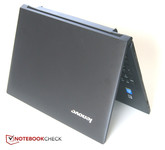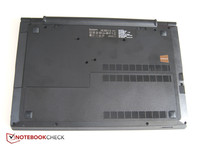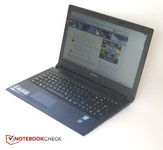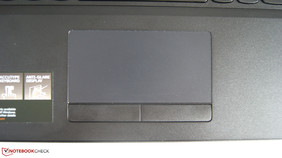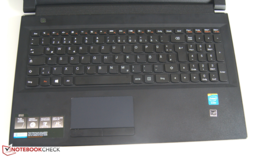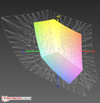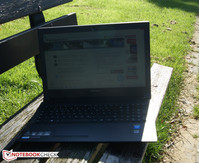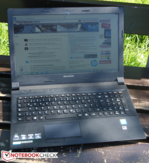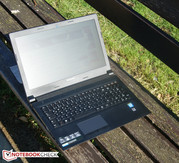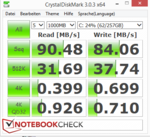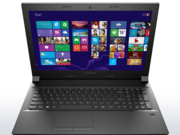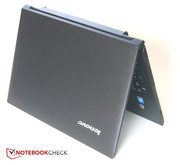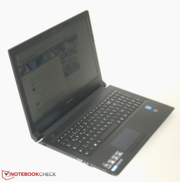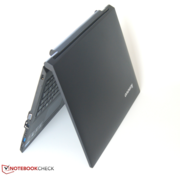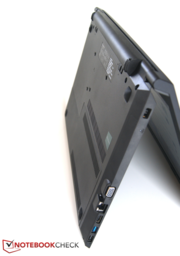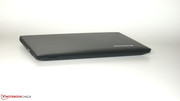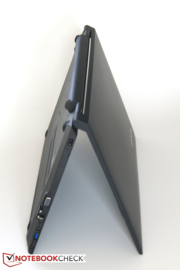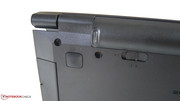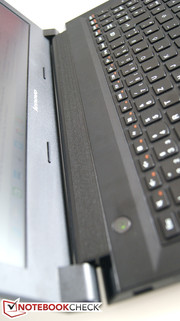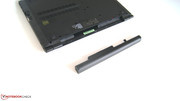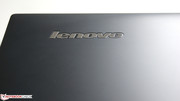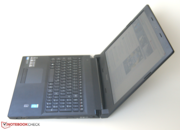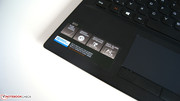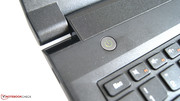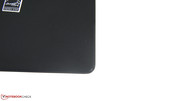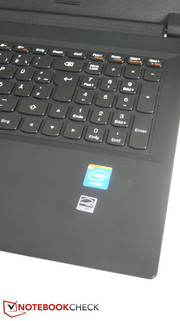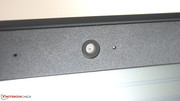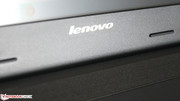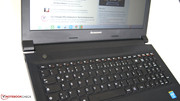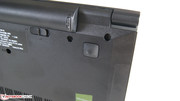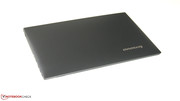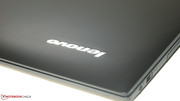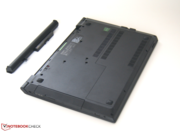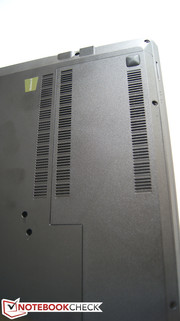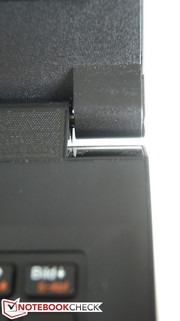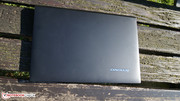Lenovo B50-30 Notebook Review

For the original German review, see here.
The multitude of devices in Lenovo's B50 product line makes an affordable entry into the laptop world possible and also provides enough freedom to attract the attention of more demanding users. In this case, we are looking at an absolute entry-level model with components that would actually be expected in a netbook but are installed in a 15.6-inch laptop. To be specific, they are Intel's Celeron N2815 CPU clocked with 1860 - 2133 MHz, a 2 GB DDR3L working memory, a 320 GB hard drive, and a TN screen with a maximum resolution of 1366x768 pixels. We are dealing with a laptop sold for approximately 270 Euros (~$363) and want to find its application fields. At the same time, we will clarify whether it can survive at all in today's office and Internet environment. However, Lenovo is not alone in this price range. We used Acer's 260 Euros (~$350) Aspire E1-532 with a 500 GB hard drive, 2 GB of working memory, and a slightly faster Intel Celeron 2955U CPU owing to its L3 cache for comparison. Another rival is Packard Bell's EasyNote TE69HW with an Intel Celeron 2957U and 4 GB working memory sold for 300 Euros (~$403). To compare AMD components, we also looked at HP's Compaq 15-h024sg available for 260 Euros (~$350). Finally, to see what would be possible for a slightly higher price, we added Asus' F551MA-SX063H with a 2167 MHz Intel Pentium N3520 CPU to the comparison group.
Case
The matte plastic casing is typical for the well-known Lenovo line-up. The subtle bluish pigments are especially striking and make the laptop look interesting particularly in very bright light. Its haptics are absolutely acceptable, and the review sample provides a good grip. The transitions of the casing's single components are nicely positioned but a bit irregular. Here, accumulated dust will only be difficult to remove. Apart from that, the matte plastic casing of Lenovo's laptop quickly attracts fingerprints. Otherwise, Lenovo's device is comfortable to hold with its rather slim height of 28 mm. Its weight of 2225 grams (including the battery) makes it pleasant to use on the lap. Maintenance is possible after removing a part of the base unit's underside as well as removing screws to lift off the keyboard.
Connectivity
The connectivity is quite sparse with only one USB 3.0 and two USB 2.0 ports. However, Lenovo's B50 provides an HDMI out and Gigabit Ethernet. The interfaces are located in the front area, which allows easy access. However, the positioning often limits the work area unpleasantly when cables are connected.
Communication
The Atheros AR9565 module installed in Lenovo's B50 exhibits obvious weaknesses in a direct Wi-Fi comparison with a MacBook Pro Retina 13 (Late 2013). Alternating test downloads were started in the test where the router was located one story over the desk. The MacBook achieved an almost full signal, in contrast to Lenovo's device that only managed about half the bandwidth. The signal strength of our review sample fluctuated between 50 and 60%. We did not ascertain a significant difference when we moved the test device to the same story as the router. In addition to Wi-Fi, the laptop also sports Bluetooth 4.0 and a Gigabit Ethernet port. The 0.3 MP webcam is unfortunately useless because recordings are not only delayed but are also displayed with immense stuttering. Regrettably, the picture is extremely distorted by a heavy noise and poor color reproduction.
Accessories
Lenovo does not include any accessories, but that was not to be expected considering the low price either. It is only shipped with two short leaflets, and neither a microfiber cloth nor an adapter are in the box.
Warranty
Apart from the two-year retailer warranty, Lenovo only includes a one-year bring-in service. It can, however, be upgraded for a surcharge when required.
Input Devices
Keyboard
Unfortunately, Lenovo's well-known Accu-Type keyboard left us with some mixed feelings. It was particularly noticed that the left half of the keyboard matrix with all its keys yielded to quite an extent when some keys were pressed. We also noticed that the keys jammed when typing faster, and that they produced a strange cracking noise. The rest of the keyboard is satisfactory though. The big arrow keys and the full-fledged number pad have to be mentioned positively. We did not discover any special keys.
Touchpad
The rather small 10 x 5 cm touchpad can score with both good finger detection and multi-touch features. However, it exhibited a few weaknesses, in form of unpleasant lags, when gestures were performed swiftly. The buttons also make an ill-conceived impression. They have noticeably different pressure points, and the bezel conveys a submerged and slightly overused feel. Spoiled hands should definitely fall back on an external mouse, but it should completely suffice for use on the go. We noticed that dust disagreeably settled between the keys after repeated use and was difficult to remove.
Display
Like all comparison models from this price range, the 15.6-inch Lenovo B50-30 is shipped with a 1366x768 pixel TN screen. Its average brightness of 200.3 cd/m² is below our annual average of 237 cd/m² ascertained in office laptops. The brightness is dimmed to 164 cd/m² in battery mode. Asus' F551MA (240.7 cd/m²) provides a considerably brighter screen. All other laptops are on par with Lenovo's. Lenovo's B50-30 also has to make concessions in the contrast and can only offer 335:1. Though a high contrast cannot be expected in this price range, it should be a bit higher than 400:1, like in the other comparison devices. HP's Compaq 15-h024sg achieves a remarkable 846:1 despite being in the same price range. In contrast, Asus' F551MA disappoints with a contrast ratio of 300:1. The resulting black level of 0.6 cd/m² is largely quite acceptable for this laptop category.
| |||||||||||||||||||||||||
Brightness Distribution: 86 %
Center on Battery: 164 cd/m²
Contrast: 335:1 (Black: 0.6 cd/m²)
ΔE ColorChecker Calman: 12.23 | ∀{0.5-29.43 Ø4.79}
ΔE Greyscale Calman: 12.29 | ∀{0.09-98 Ø5}
38.91% AdobeRGB 1998 (Argyll 1.6.3 3D)
42.05% AdobeRGB 1998 (Argyll 3D)
61.1% sRGB (Argyll 3D)
40.67% Display P3 (Argyll 3D)
Gamma: 2.16
CCT: 14912 K
The AdobeRGB color space coverage is essential for professional image editing. However, it is clearly missed with a coverage of 38.96%. The Grayscale shift in CalMAN achieves a DeltaE rate of 12.29. This is definitely too high and leads to a visible bluish cast. The shift of 12.29 in the ColorChecker test is just as high. Asus' F551MA achieves considerably better rates here (Grayscale: 4.57 dE; ColorChecker: 4.7 dE).
The matte screen makes outdoor use quite possible, particularly in the shade. Nevertheless, direct or indirect sunlight should be avoided to the largest extent due to the low brightness. Overall, Lenovo's laptop can be used well outdoors.
As to the viewing angles, evident color deviations and brightness differences are particularly noticed when the screen is tilted. The low contrast causes problems here and can, for example, make it difficult to see the time in the Windows taskbar. The opening angle could be a bit bigger than just below 135 degrees.
Performance
Lenovo's B50-30 should be apt for routine office tasks. Intel's Celeron N2815 (Bay Trail dual-core SoC) and the integrated Intel HD graphics card make other application scenarios, such as gaming, difficult. Future versions with Intel's Pentium N3520 CPU should provide a clear, and at the same time affordable, performance boost. The price difference will likely be about 50 - 70 Euros (~$67 - ~$94), but the manufacturer has not made any statement to date. Other CPUs, for example, from Intel's Core-i line-up, can also be installed, and even a dedicated Nvidia GeForce 820M finds room in Lenovo's configuration. The 2 GB working memory installed by standard is very tight for today's purposes, and it caused massive problems in the benchmarks because Lenovo reserves large parts of the working memory for third-party software. These programs first had to be deleted from the cache for successful test runs.
Processor
The Intel Celeron N2815 installed in Lenovo's device has a clock rate of 1860 - 2133 MHz and is usually found in netbooks. Its power consumption is low with a TDP of 7.5 watts.
The CPU is compared with equally priced contenders in Cinebench in order to present possible alternatives. The comparison with the optionally available Intel Pentium N3520 is particularly interesting. It achieved an almost three-times higher score than the Intel Celeron N2815 in Lenovo's laptop with 1.75 points in the multi-core test of Cinebench R11.5. Only AMD's E1-2100 CPU in HP's Compaq 15-h024sg lags behind Intel's Celeron N2815 by approximately 26%. The score ratios were all maintained in the single-core test, with exception of the Intel Pentium N3520 in Asus' device. It reaped in just below 38% more points but is clearly behind the rates of the otherwise weaker Intel Celeron 2955U in Acer's laptop or the Intel Celeron 2957U in Packard Bell's device.
The test of the CPU's performance in battery mode did not show any significant differences in either the multi-core or single-core tests of Cinebench R11.5.
System Performance
Seen only subjectively, Lenovo's laptop needs a long time for loading operations. Basic tasks, such as opening folders and web browsers, require patience. Office tasks can be performed but are very time-consuming with extensively filled spreadsheets or long texts. This subjective impression of the system performance is reflected extremely unmistakably in the PCMark 7 score. All comparison devices could reap in considerably more points. Even HP's Compaq 15-h024sg configured with AMD components achieved an approximately 24% higher score. A clear distinction is seen in Packard Bell's EasyNote TE69HW with 160% and Asus G551MA with 127%. The superfluous third-party software should definitely be deleted to achieve a higher system performance. Additionally, a working memory upgrade or CPU replacement should be considered.
| PCMark 7 Score | 787 points | |
Help | ||
Storage Devices
The installed Seagate ST320LT012 has a capacity of 320 GB and spins with 5400 revolutions per minute. The read and write rates achieved in CrystalDiskMark 3.0 are on the average for this type of hard drive. There are no major differences to the competition because none offer an expensive SSD drive. However, Asus' F551MA and Acer's Aspire E1-532 provide good comparison values owing to better read and write speeds.
It should also be kept in mind that a lot of third-party software is installed, and thus only just below 260 GB of storage is available. The rest is allocated for the recovery partition.
Graphics Card
The Intel HD Graphics (Bay Trail) integrated into Intel's Celeron N2815 is a slimmed version of Intel's HD Graphics (Sandy Bridge) and also has a lower clock with 311 - 869 MHz and only four pipelines in contrast to six. We could ascertain a dynamic clock variation ranging from 400 - 755.6 MHz. The Bay Trail model is mostly used in netbooks or tablets and rarely in laptops like in this case. More information and benchmarks can be found in our graphics card section. Lenovo caused a few problems in our tests, and thus we could not perform 3DMark06 because the driver that Lenovo installed was not certified and only this Lenovo driver could be installed. Furthermore, background programs had to be closed because they would have otherwise terminated the tests due to insufficient working memory resources.
The analysis of the 3DMark 11 benchmark shows that both Acer's Aspire E1-532 and Packard Bell's EasyNote TE69HW achieve an over two-times higher score of Lenovo's 218 points owing to their newer Haswell Intel HD Graphics. Thus, Lenovo comes in last in this test and is also defeated by AMD's Radeon HD 8210 in HP's Compaq 15-h024sg.
| 3DMark 11 Performance | 218 points | |
| 3DMark Ice Storm Standard Score | 5578 points | |
| 3DMark Cloud Gate Standard Score | 511 points | |
Help | ||
| 3DMark 11 - 1280x720 Performance (sort by value) | |
| Lenovo B50-30 | |
| Acer Aspire E1-532 | |
| Packard Bell EasyNote TE69HW-29574G50Mnsk | |
| HP Compaq 15-h024sg | |
| Asus F551MA-SX063H | |
Gaming Performance
It should be more or less clear that Lenovo's laptop is not designed for gaming due to the installed Intel HD Graphics (Bay Trail). At most, old classics should run smoothly on Lenovo's device. 29 frames per second in FIFA 14 conveys the impression of a fairly playable presentation, but they were permanently interrupted by extreme stutters in the test. Consequently, gaming is not recommendable.
Emissions
System Noise
Owing to the energy-efficient entry-level processor alongside the integrated graphics card, Lenovo's laptop is barely, or better said, not at all audible in both idle and load operations. The waste heat can be discharged without noisy fans due to its size and the Celeron CPU. Contenders like Acer's Aspire E1-532 or Packard Bell's EasyNote TE69HW are audible with up to 33.5 dB(A) during load, but they are not distracting.
Noise level
| Idle |
| 28 / 28 / 28 dB(A) |
| HDD |
| 28.3 dB(A) |
| Load |
| 28 / 28 dB(A) |
 | ||
30 dB silent 40 dB(A) audible 50 dB(A) loud |
||
min: | ||
Temperature
The temperatures of Lenovo's device stay quite low during all operations due to the installed components. The keyboard surface got noticeably warm but not unpleasant after longer test phases. An obvious temperature increase was only recorded on the underside during the stress test. The hot spot was a high 46.5 °C here. The components did not reach uncomfortable rates. However, this is not a problem since this situation will rarely occur. The heat discharged from Lenovo's device does not have direct contact with the thighs during use on the lap because the battery lifts the laptop a bit.
(+) The maximum temperature on the upper side is 38.1 °C / 101 F, compared to the average of 34.3 °C / 94 F, ranging from 21.2 to 62.5 °C for the class Office.
(-) The bottom heats up to a maximum of 46.5 °C / 116 F, compared to the average of 36.8 °C / 98 F
(+) In idle usage, the average temperature for the upper side is 28.8 °C / 84 F, compared to the device average of 29.5 °C / 85 F.
(±) The palmrests and touchpad can get very hot to the touch with a maximum of 36.6 °C / 97.9 F.
(-) The average temperature of the palmrest area of similar devices was 27.6 °C / 81.7 F (-9 °C / -16.2 F).
Speakers
Lenovo installs stereo speakers with integrated Dolby® Advanced Audio™ that we could, unfortunately, not test because they were either defect in our review sample, or we could not find the solution for the repair.
Energy Management
Power Consumption
We did not ascertain any irregularities or the like in the power-consumption analysis. Lenovo's device remains 1.5 watts behind all contenders with an idle average of 3.1 watts. The 60-watt power supply can easily provide the maximum 12.2 watts required during load.
| Off / Standby | |
| Idle | |
| Load |
|
Key:
min: | |
Battery Runtime
The 4-cell li-ion battery has a capacity of 32 Wh, which is 5 Wh less than its contenders. It looks quite small due to the low diameter of the removable, cylindrical battery.
We perform tests to simulate the three most significant application scenarios. The laptop performs a read test in the idle scenario using minimum brightness. It shut down after 6:40 h, which corresponds to the 6.5 h of runtime that Lenovo specifies. Acer's Aspire E1-532 lasts considerably longer with a good 10 h, for example.
This ratio is maintained in the Wi-Fi test that simulates browsing through different websites. Lenovo's B50-30 achieved 3 h and 37 min here and thus almost one hour less than all contenders. Asus' F551MA comes closest with 40 minutes more. The laptop achieved the same runtime in load operation as in the Wi-Fi test. The reason for this is that the CPU's performance is maxed-out when opening different websites and YouTube videos. However, Acer's Aspire E1-532 only lasts 1:32 h.
Consequently, an additional battery will be needed to overcome a whole workday, or another laptop should be considered.
Verdict
We summarize all important points of the test report and create two subcategories for these in the verdict. First, we should list what we can and should expect for 270 Euros (~$363). Lenovo's B50-30 is offered as an office laptop and should fulfill these tasks to some extent. A certain demand on the input devices is justified for typing. Unfortunately, they exhibit a few shortcomings. Though the keyboard provides an agreeable pressure point, it yields in some areas which makes typing quickly difficult. The touchpad is a bit too small but features good responsiveness. The buttons are its biggest drawback because their different pressure points and the bezel make use unpleasant. The screen is acceptable in view of the price, but the contrast could nevertheless be quite a bit higher. One of the most essential points is the performance in office and Internet operations. The contenders reap in a better rating due to the tight working memory and the weak Celeron CPU. Lenovo unnecessarily limits the operating speed with masses of third-party software. Positives about Lenovo's laptop are its slim build and pleasant weight. Users looking for power can, however, find better alternatives in this price range or opt for a future version of the B50 models with an Intel Pentium N3520 and more working memory.




